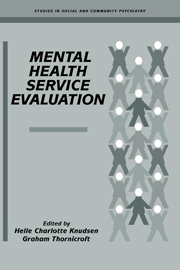Book contents
- Frontmatter
- Contents
- List of contributors
- Foreword
- Preface
- Part I INTRODUCTION
- Part II COMPREHENSIVE SERVICE EVALUATION PROJECTS
- 5 The Copenhagen Community Psychiatric Project (CCPP)
- 6 The Mannheim Project
- 7 Psychiatric evaluation as a process of quality assurance
- Part III METHODS: MEASUREMENT, STRATEGIES AND NEW APPROACHES
- Part IV SYSTEM-LEVEL RESEARCH
- Part V PROGRAMME-LEVEL RESEARCH
- Part VI HEALTH ECONOMICS IN MENTAL HEALTH
- Index
7 - Psychiatric evaluation as a process of quality assurance
from Part II - COMPREHENSIVE SERVICE EVALUATION PROJECTS
Published online by Cambridge University Press: 05 August 2016
- Frontmatter
- Contents
- List of contributors
- Foreword
- Preface
- Part I INTRODUCTION
- Part II COMPREHENSIVE SERVICE EVALUATION PROJECTS
- 5 The Copenhagen Community Psychiatric Project (CCPP)
- 6 The Mannheim Project
- 7 Psychiatric evaluation as a process of quality assurance
- Part III METHODS: MEASUREMENT, STRATEGIES AND NEW APPROACHES
- Part IV SYSTEM-LEVEL RESEARCH
- Part V PROGRAMME-LEVEL RESEARCH
- Part VI HEALTH ECONOMICS IN MENTAL HEALTH
- Index
Summary
The Nacka Project revisited
Ten years after the introduction of the Community Health Services system in the United States, a study by the National Board of Health and Welfare in Sweden recommended that adult psychiatric services should be reconstructed so as to provide more open forms of care managed by multiprofessional teams and based on a total care responsibility for a defined catchment area. One of the first clinics in Sweden to be organised according to these principles was located in a Stockholm suburb. The Nacka Project (NP), as it was called, was to be run as a pilot scheme for 2 years (1975-76) whilst undergoing continual evaluation.
The aim of the present study is to describe how the evaluation of this organisational change was carried out, as well as some of the effects of the change. A further aim is to give an account of how continual evaluation in close association with clinical practice can be used to monitor and guide the enterprise towards targeted goals and/or improved efficiency. Discussions about the quality of care often start with Donabedian's concepts - structure, process and effect quality-from the patient's perspective (Donabedian, 1966). The present study adopts instead a perspective by which the care organisation in its entirety, as well as its relationship to the catchment area population, is focused upon. It is an attempt which can be characterised as population-focused quality assurance.
Study area and method
The study population consisted of all persons aged 18 years and above in two outer suburbs of Stockholm who had sought psychiatric care in the catchment area at any time during 1972-3 (the old organisation) and 1975-6 (the new organisation, i.e. the NP). Data from these patients was included in a psychiatric case register for these periods. A new patient register was set up during the period 1981-5, containing the same type of information for the area. Patient and treatment characteristics could thus be compared over three periods of time, thereby reflecting organisational changes.
In 1975, the inhabitants of the catchment area numbered 71 400, of whom 51 300 were aged 18 and above. Ten per cent of the population lived in rural, sparsely populated areas.
- Type
- Chapter
- Information
- Mental Health Service Evaluation , pp. 96 - 118Publisher: Cambridge University PressPrint publication year: 1996



